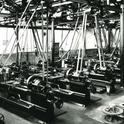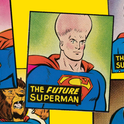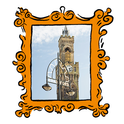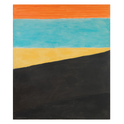William Buroughs in front of his “shotgun paintings.”
What do we want from pictures of writers? More than we’re willing to admit. That, at least, was the conclusion I came to after reading Portrait of the Writer, which gathers some 250 portraits of writers and pairs them with capsule biographies by Goffredo Fofi and six other contributors in the hopes of discovering “something previously unrevealed” about them. But what it mostly provides is either the familiar—what Hemingway looked like, how Camus held a cigarette—or the banal, like the size of Eugenio Montale’s head and the layout of Mario Vargas Llosa’s study.
So what was I looking for? Something beyond the mundane details of authors’ looks and photographers’ conceits. Something to bring me up short. Leafing through Portrait of the Writer, I recalled a story from a book about the early 20th century Ukrainian anarchist Nestor Makhno. The woman who runs the local museum in Makhno’s hometown recounts an incident from her childhood. She had grown up in a village called Hrushevo, lost in the vastness of the Ukrainian steppe. It was a place without electricity, where postmen and salesclerks were revered because their jobs brought them into contact with money and the written word. One day the woman, then a girl, visited her neighbour’s house and saw a portrait of the poet Taras Shevchenko on the wall. Not knowing who it was, she asked, “Is it God?,” to which the owner of the house replied, “No, a prophet.”
We’re supposed to be past this sort of reverence now. For many decades, it has been academic orthodoxy that the author is dead. Since the rise of post-structuralism in the mid-20th century, students have been taught that literary works and their producers are temporary knots in the eternal flow of discourse. But I’m not sure anyone is really able to think about authors like this in a sustained way. Not when books are important to us. Certainly not when, as teenagers, we begin to read seriously. As much as we try to disavow it, literature is still a game of identification. And the more we identify, the more we crave the presence of the body, if only in a picture. We want prophets.
Writers aren’t immune to the charisma of the author either. Don DeLillo once told an interviewer that he keeps a photograph of Jorge Luis Borges on his desk next to his typewriter, as an aid to concentration. Whenever he finds his mind wandering, he looks at Borges, “fierce, blind, his nostrils gaping, his skin stretched taut… like a shaman painted for visions,” and tries to use him as his guide “out of lethargy and drift, into the otherworld of magic, art, and divination.” DeLillo has thought a great deal about writers and photography. In his novel Mao II, Brita, a photographer pursuing a project of documenting all writers in the world, asks the crucial question: “What’s the importance of a photograph if you know the work? I don’t know. But people still want the image, don’t they? The writer’s face is the surface of the work. It’s a clue to the mystery inside.”
For Geoff Dyer, the mystery was embodied in a photograph of DH Lawrence taken by Edward Weston in Mexico City in 1924. “More than any other pictures of Lawrence, Weston’s show—to those of us who never set eyes on him, who know him mainly through his words—what Lawrence really looked like. The very simplicity of this achievement grants it the quality of a revelation.” For Walter Benjamin, a picture of Kafka taken when he was a child was a guide to divination. The portrait, taken when Kafka was five or six, shows the writer posed against a vaguely tropical background holding a wide-brimmed hat and dressed in a “tight, heavily lace-trimmed, almost embarrassing” child’s suit, which makes him look like a tiny jockey.
The picture of Kafka included in Portrait of the Writer is from a later date (“unknown photographer, unknown location”), though contributor Alessia Tagliaventi seems to share some of Benjamin’s opinion of Kafka’s gaze, noting that in most of his photographs it seems “both profound and enigmatic.” It’s a shame the book doesn’t include a photograph of Benjamin himself, especially since his face—walrusy, near-sighted, and intensely absorbed—has been identified as the image of readerly intelligence by everyone from Susan Sontag to Zadie Smith.
One of the few major writers who herself doubled as a photographer was Eudora Welty. The short story that marked Welty’s breakthrough, “Why I Live at the P.O.” was even inspired by one of the pictures she took on her travels across the Depression-era South. In Portrait of the Writer, she is represented by an austere self-portrait in which she leans against a ruined wooden-plank wall that looks as if it could have been borrowed from Walker Evans’s images of this era.
The envelope of privacy Welty holds onto in front of the camera makes her portrait one of the better ones in the book. But that kind of reserve is rare. Many of the pictures in the collection are fairly bland pieces of publicity, endless variations on photographers trying to make their subjects look thoughtful, either by looking down, holding their glasses, peering through a window or leafing through a book. It’s even worse when they try to make a picture that accords in some way with their idea of the writer’s work, like Philip K Dick portrayed as a disembodied head on a subway seat, or Italo Calvino, holding an orb. Worst of all are the portraits that strive for whimsy, like Aldous Huxley, and Orhan Pamuk, both caught in mid-leap. (Writers! Don’t let anyone convince you to jump for the camera. It looks terrible.)
Occasionally though, a portrait will conspire with its environment to create an image that condenses something larger about a time and place. Sometimes they allow us to see a stage in a writer’s transformation. Hemingway once wrote that Gertrude Stein began her stay in Paris looking like a Friulian peasant and ended up resembling a Roman emperor. Here, photographed in 1944 in newly liberated France, she’s already well on the way to the emperor phase. But next to her, Alice B Toklas looks as if she just heard a dirty joke she can’t wait to repeat.
At other times these photos seem to contain a whole epoch. The poet Vladimir Mayakovsky, by Alexander Rodchenko, with his shaved head and burning eyes, is the Soviet 1920s. Dashiell Hammett at a train yard, dressed in a three-piece suit and homburg, looks as hard-boiled as you would hope the author of The Maltese Falcon would be. Proust, on his deathbed in 1922, by Man Ray, looking rather like an El Greco saint, shuts the door on one era of literary Paris. Camus, smoking on a bridge in 1944 by Henri Cartier-Bresson, opens a window on another.
Images such as these typically result from a close collaboration between subject and photographer. More frequently though, a photographer will be overwhelmed by a writer’s self-image, and find little to contribute of his own. Richard Avedon describes taking a picture of Borges in his home in Buenos Aires. Borges made him perform the same ritual he put all his visitors through, having him read a specific passage of Kipling after which he recited Anglo-Saxon elegy. As a result, Avedon felt that he was unable to bring anything of his own to the process, and the resulting portrait felt empty: “Borges’s performance permitted no interchange. He had taken his own portrait long before, and I could photograph only that.”
This is an odd thing for him to think, since Avedon’s great talent was for capturing precisely what his subjects thought they were to begin with. This gift is on display in Portrait of the Writer, especially in Avedon’s portraits of Ezra Pound as bare-chested, yelling oracle and of Auden striding hunched down a snowy New York street, radiating exile, seriousness and gravity. Avedon’s skill at realising authors’ visions of themselves makes his portrait of Truman Capote from 1959 especially interesting. In it, Capote is shirtless. His eyes are closed, his head is tilted up and his hands are clasped behind his back in the demure posture of a Mannerist saint about to undergo some ravishing trial, like being shot through with arrows or eaten by a lion.
The accompanying biography describes the picture as “dreamlike, elegant, and feminine.” But it is more than that. Avedon’s photograph is the culmination of a project of self-reinvention Capote began over a decade earlier, with the publication of his first book, Other Voices, Other Rooms. On the back cover Capote is shown in languid repose, dressed, in the words of the New Yorker critic Hilton Als, “as an American woman of style.” As Als notes in his superb new book White Girls: “It is an image that is an assertion, a point, asserting this: I am a woman.” In the end, Capote’s persona overcame anything Avedon might hope to do in the portrait.
Other writers have been similarly swamped by their images. Two that come to mind from Portrait of the Writer are Paul Auster and William Burroughs. Auster’s author photo, with its characteristic arched eyebrow and tormented stare, bothered me for years from the back of used paperbacks. One of the book’s contributors, Maria Baiocchi, says that Auster looks like “an intense and inscrutable character, absorbed in the process of self-analysis.” But to me he looks like someone who has spent far too long believing his own bullshit.
Burroughs for his part spent so many years pretending to be a sleazebag that the act became seamless, and it’s a mask—the reprobate-grifter-genius—that’s given him ample afterlife on the internet. In his portrait, he’s caught in one of his lounge lizard suits posing with a double barreled shotgun—in front of two paintings he made with it. (Burroughs created these “shotgun paintings” by shooting cans of paint in front of a canvas.) It’s a somewhat off-putting image given that Burroughs accidentally shot and killed his first wife in 1951, and also funny for its extreme bad taste. But it’s also a cliché, as so many photographs of authors are.
Without a single focus, a thesis, or something integral motivating the different photographers, Portrait of the Writer threatens to become just data—who wore a suit, who smoked a pipe, who was crass enough to be photographed in front of a typewriter. After a while, flipping through starts to feel like playing a game of pseudo-intellectual Hot-or-Not with a deck of 250. I wouldn’t discount physical beauty entirely though. Roland Barthes famously wrote that every photograph is a picture of death. But some pictures, of certain faces, push against that gloom. There’s a way in which Zadie Smith and Gore Vidal are beautiful now, whereas the faces of Kafka and Mayakovsky tell us that they’re doomed—they’re always going to die.
Ultimately, the best photographs of authors do not present them as publicity objects or prophets. The best offer intimacy and invite the onlooker in. My favourites tend not to frame their subjects too closely, leaving space in which to lose yourself. As soon as I see the novelist Naguib Mahfouz at the head of a sleepy boulevard in Cairo, I know that’s a street I’d like to walk down. I want to join the writer and filmmaker Pier Paolo Pasolini in this football game in the outskirts of Rome. Best of all is the picture of Fernando Pessoa, taken anonymously on a Lisbon street. Pessoa, who was famous for hiding his literary work behind dozens of alter egos, is on a tiled sidewalk, coming out of a crowd toward the photographer without being aware of his presence. Who would take a picture of him like this, mid-stride, seemingly without his permission? A policeman, an admirer, a detective? Pessoa holds a coat and a newspaper in one arm. His moustache, hat, and glasses, look like a disguise. Is it even him?
Portrait of the Writer: Literary Lives in Focus. Foreword by Goffredo Fofi (Thames & Hudson, £24.95)












